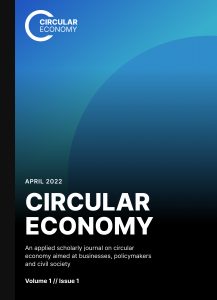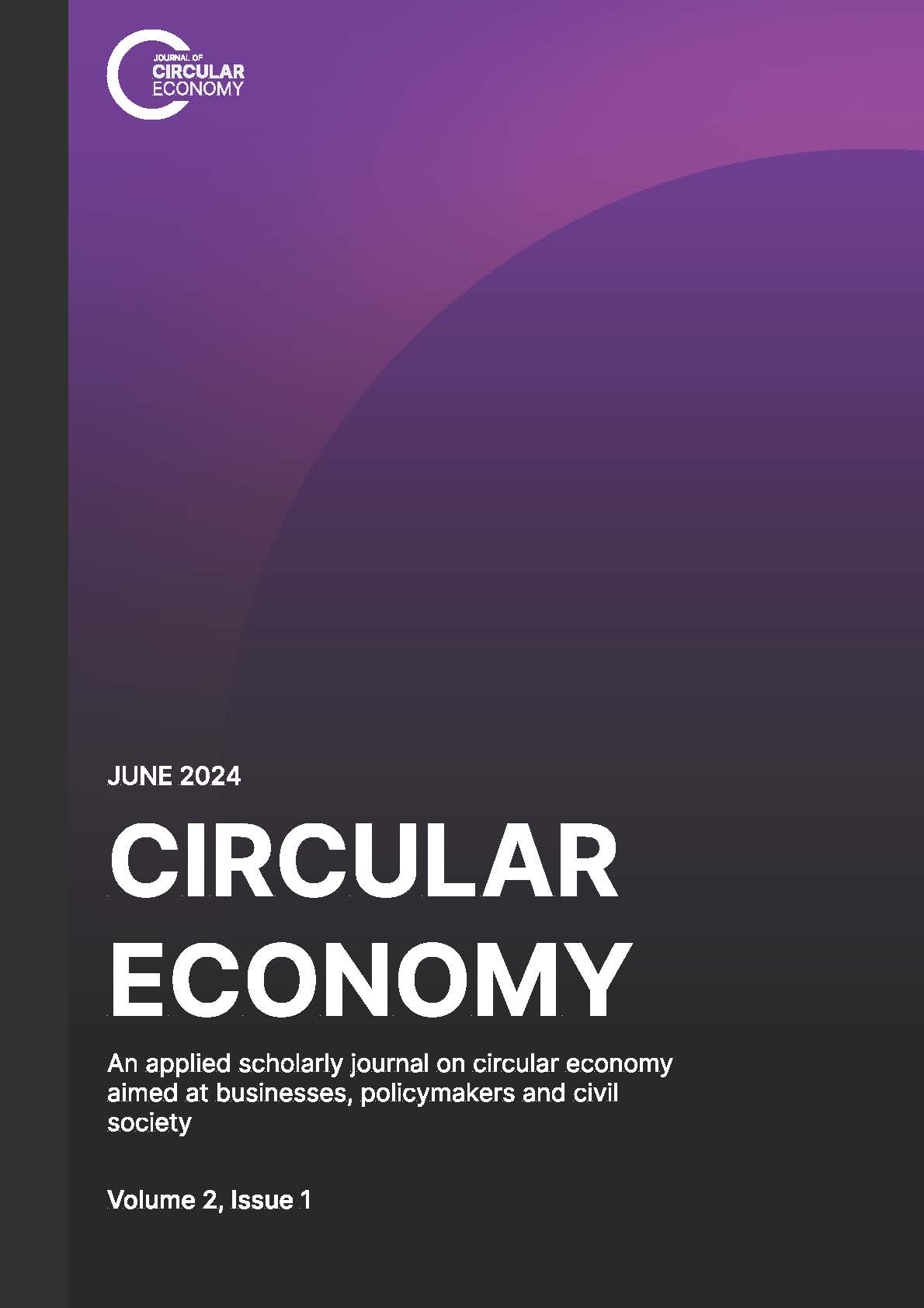Abstract
The circular economy has gained significance in recent years due to its potential to achieve economic benefits and address ecological challenges. Mechanical engineering companies face the challenge of transitioning to a circular economy, which offers advantages like improved resource utilisation, reduced dependence on external suppliers, and enhanced production and supply chain efficiency. However, implementing circular economy principles proves difficult for manufacturing firms. Measuring circularity poses significant challenges, necessitating assessing methods' development, application, and validation. Industry-specific key indicators and data quality assurance are crucial in this regard. Existing models struggle to adapt to diverse contexts and industries. The outcome of this paper is the C-METRIC (Circular Manufacturing Evaluation and Rating for Industrial Circularity), an industry-specific method for assessing mechanical engineering companies' circularity and maturity level, developed using the Design-Science-Research Methodology. Based on the circular value chain, the method evaluates the maturity and circularity levels of the focused sector through 66 specific questions in 33 different areas of the company. The results are divided into the maturity and circularity levels of value-adding and strategic processes and are visualised using spider diagrams. The purpose of this model is to survey the circularity and circular economy maturity of mechanical engineering companies of specific regions and sectors.
Keywords
References
Aguiar, M. F., & Jugend, D. (2022). Circular product design maturity matrix: A guideline to evaluate new product development in light of the circular economy transition. Journal of Cleaner Production, 365, 132732. https://doi.org/10.1016/j.jclepro.2022.132732
Agyemang, M., Kusi-Sarpong, S., Khan, S. A., Mani, V., Rehman, S. T., & Kusi-Sarpong, H. (2019). Drivers and barriers to circular economy implementation: An explorative study in Pakistan’s automobile industry. Management Decision, 57(4), 971–994. https://doi.org/10.1108/MD-11-2018-1178
Ahmed, A. A., Nazzal, M. A., Darras, B. M., & Deiab, I. M. (2022). A comprehensive multi-level circular economy assessment framework. Sustainable Production and Consumption, 32, 700–717. https://doi.org/10.1016/j.spc.2022.05.025
Averina, E., Frishammar, J., & Parida, V. (2022). Assessing sustainability opportunities for circular business models. Business Strategy and the Environment, 31(4), 1464–1487. Scopus. https://doi.org/10.1002/bse.2964
Baker, M. J., & Baker, M. J. (1991). Research for marketing. Macmillan.
Baratsas, S. G., Pistikopoulos, E. N., & Avraamidou, S. (2022). A quantitative and holistic circular economy assessment framework at the micro level. Computers & Chemical Engineering, 160, 107697. https://doi.org/10.1016/j.compchemeng.2022.107697
Bititci, U. S., Garengo, P., Ates, A., & Nudurupati, S. S. (2015). Value of maturity models in performance measurement. International Journal of Production Research, 53(10), 3062–3085. https://doi.org/10.1080/00207543.2014.970709
Blomsma, F., Bauwens, T., Weissbrod, I., & Kirchherr, J. (2023). The ‘need for speed’: Towards circular disruption—What it is, how to make it happen and how to know it’s happening. Business Strategy and the Environment, 32(3), 1010–1031. https://doi.org/10.1002/bse.3106
BMK, B. (Bundesministerium für K., Umwelt, Energie, Mobilität, Innovation und Technologie). (2022). Österreich auf dem Weg zu einer nachhaltigen und zirkulären Gesellschaft Die österreichische Kreislaufwirtschaftsstrategie.
Bocken, N. M. P., Olivetti, E. A., Cullen, J. M., Potting, J., & Lifset, R. (2017). Taking the Circularity to the Next Level: A Special Issue on the Circular Economy. Journal of Industrial Ecology, 21(3), 476–482. https://doi.org/10.1111/jiec.12606
Bressanelli, G., Perona, M., & Saccani, N. (2021). Assessing the readiness of manufacturing companies for the Circular Economy: An analysis and an initial proposal. Proceedings of the Summer School Francesco Turco. Scopus.
Cagno, E., Neri, A., Howard, M., Brenna, G., & Trianni, A. (2019). Industrial sustainability performance measurement systems: A novel framework. Journal of Cleaner Production, 230, 1354–1375. https://doi.org/10.1016/j.jclepro.2019.05.021
Cayzer, S., Griffiths, P., & Beghetto, V. (2017). Design of indicators for measuring product performance in the circular economy. International Journal of Sustainable Engineering, 1–10. https://doi.org/10.1080/19397038.2017.1333543
Chen, C.-W. (2020). Improving Circular Economy Business Models: Opportunities for Business and Innovation : A new framework for businesses to create a truly circular economy. Johnson Matthey Technology Review, 64(1), 48–58. https://doi.org/10.1595/205651320X15710564137538
Circle Economy & ARA. (2019). Circularity Gap Report Austria—Insights—Circle Economy. https://www.circle-economy.com/resources/circularity-gap-report-austria
CircularTRANS. (2020). CircularTRANS. Mondragon Unibertsitatea. https://circulartrans.mondragon.edu/en/home
Cloquell-Ballester, V.-A., Cloquell-Ballester, V.-A., Monterde-Díaz, R., & Santamarina-Siurana, M.-C. (2006). Indicators validation for the improvement of environmental and social impact quantitative assessment. Environmental Impact Assessment Review, 26(1), 79–105. https://doi.org/10.1016/j.eiar.2005.06.002
Creswell, J. W., & Plano Clark, V. L. (2018). Designing and conducting mixed methods research (Third Edition). SAGE.
Eisenreich, A., Füller, J., & Stuchtey, M. (2021). Open Circular Innovation: How Companies Can Develop Circular Innovations in Collaboration with Stakeholders. Sustainability, 13(23), Article 23. https://doi.org/10.3390/su132313456
Eisenreich, A., Füller, J., Stuchtey, M., & Gimenez-Jimenez, D. (2022). Toward a circular value chain: Impact of the circular economy on a company’s value chain processes. Journal of Cleaner Production, 378, 134375. https://doi.org/10.1016/j.jclepro.2022.134375
Elia, V., Gnoni, M. G., & Tornese, F. (2017). Measuring circular economy strategies through index methods: A critical analysis. Journal of Cleaner Production, 142, 2741–2751. https://doi.org/10.1016/j.jclepro.2016.10.196
Ertz, M., Leblanc-Proulx, S., Sarigöllü, E., & Morin, V. (2019). Made to break? A taxonomy of business models on product lifetime extension. Journal of Cleaner Production, 234, 867–880. https://doi.org/10.1016/j.jclepro.2019.06.264
European Commission. (2006). REGULATION (EC) No 1893/2006 OF THE EUROPEAN PARLIAMENT AND OF THE COUNCIL: establishing the statistical classification of economic activities NACE Revision 2 and amending Council Regulation (EEC) No 3037/90 as well as certain EC Regulations on specific statistical domains.
Eurostat. (2022). Circular economy monitoring framework. CIRCULAR ECONOMY Monitoring Framework. https://ec.europa.eu/eurostat/cache/scoreboards/circular-economy/
Fontana, A., Barni, A., Leone, D., Spirito, M., Tringale, A., Ferraris, M., Reis, J., & Goncalves, G. (2021). Circular Economy Strategies for Equipment Lifetime Extension: A Systematic Review. Sustainability, 13(3), Article 3. https://doi.org/10.3390/su13031117
Franco, N. G., Almeida, M. F. L., & Calili, R. F. (2021). A strategic measurement framework to monitor and evaluate circularity performance in organizations from a transition perspective. Sustainable Production and Consumption, 27, 1165–1182. https://doi.org/10.1016/j.spc.2021.02.017
Garza-Reyes, J. A., Salomé Valls, A., Peter Nadeem, S., Anosike, A., & Kumar, V. (2019). A circularity measurement toolkit for manufacturing SMEs. International Journal of Production Research, 57(23), 7319–7343. https://doi.org/10.1080/00207543.2018.1559961
Govindan, K., & Hasanagic, M. (2018). A systematic review on drivers, barriers, and practices towards circular economy: A supply chain perspective. International Journal of Production Research, 56(1–2), 278–311. https://doi.org/10.1080/00207543.2017.1402141
Groves, R. M. (Hrsg.). (2009). Survey methodology (2nd ed). Wiley.
Hill, T., & Lewicki, P. (2006). Statistics: Methods and applications: a comprehensive reference for science, industry, and data mining. StatSoft.
Huber-Heim, K., & Kronenberg, C. (2021). Unternehmen auf dem Weg zur Kreislaufwirtschaft—Studie zu Perspektiven Wissensstand und Erwartungen der österreichischen Stakeholder. https://www.circulareconomyforum.at/2021/circular-economy-forum-austria-veroeffentlicht-studie-zu-erwartungen-und-perspektiven-von-stakeholdern-an-eine-kreislaufwirtschaft/
Inèdit. (2020). Inèdit—Autoevalúate. https://circular.ineditinnova.com/index/es
Jakhar, S. K., Mangla, S. K., Luthra, S., & Kusi-Sarpong, S. (2018). When stakeholder pressure drives the circular economy: Measuring the mediating role of innovation capabilities. Management Decision, 57(4), 904–920. https://doi.org/10.1108/MD-09-2018-0990
Joshi, A., Kale, S., Chandel, S., & Pal, D. (2015). Likert Scale: Explored and Explained. British Journal of Applied Science & Technology, 7, 396–403. https://doi.org/10.9734/BJAST/2015/14975
Kayikci, Y., Kazancoglu, Y., Gozacan-Chase, N., Lafci, C., & Batista, L. (2022). Assessing smart circular supply chain readiness and maturity level of small and medium-sized enterprises. Journal of Business Research, 149, 375–392. Scopus. https://doi.org/10.1016/j.jbusres.2022.05.042
Kirchherr, J., Reike, D., & Hekkert, M. (2017). Conceptualizing the circular economy: An analysis of 114 definitions. Resources, Conservation and Recycling, 127, 221–232. https://doi.org/10.1016/j.resconrec.2017.09.005
Kravchenko, M., McAloone, T. C., & Pigosso, D. C. A. (2019). Implications of developing a tool for sustainability screening of circular economy initiatives. Procedia CIRP, 80, 625–630. https://doi.org/10.1016/j.procir.2019.01.044
Kristensen, H. S., & Mosgaard, M. A. (2020). A review of micro level indicators for a circular economy – moving away from the three dimensions of sustainability? Journal of Cleaner Production, 243, 118531. https://doi.org/10.1016/j.jclepro.2019.118531
Lacy, P., Long, J., & Spindler, W. (2020). The Circular Economy Handbook: Realizing the Circular Advantage. Palgrave Macmillan UK. https://doi.org/10.1057/978-1-349-95968-6
Linder, M., Sarasini, S., & van Loon, P. (2017). A Metric for Quantifying Product-Level Circularity. Journal of Industrial Ecology, 21(3), 545–558. https://doi.org/10.1111/jiec.12552
Montag, L., Klünder, T., & Steven, M. (2021a). Paving the Way for Circular Supply Chains: Conceptualization of a Circular Supply Chain Maturity Framework. Frontiers in Sustainability, 2. https://www.frontiersin.org/articles/10.3389/frsus.2021.781978
Montag, L., Klünder, T., & Steven, M. (2021b). Paving the Way for Circular Supply Chains: Conceptualization of a Circular Supply Chain Maturity Framework. Frontiers in Sustainability, 2. https://www.frontiersin.org/articles/10.3389/frsus.2021.781978
Nightingale, A. (2009). A guide to systematic literature reviews. Surgery (Oxford), 27(9), 381–384. https://doi.org/10.1016/j.mpsur.2009.07.005
Parchomenko, A., Nelen, D., Gillabel, J., & Rechberger, H. (2019). Measuring the circular economy—A Multiple Correspondence Analysis of 63 metrics. Journal of Cleaner Production, 210, 200–216. https://doi.org/10.1016/j.jclepro.2018.10.357
Peffers, K., Tuunanen, T., Rothenberger, M., & Chatterjee, S. (2007). A design science research methodology for information systems research. Journal of Management Information Systems, 24, 45–77.
Pigosso, D. C. A., & McAloone, T. C. (2021). Making the transition to a Circular Economy within manufacturing companies: The development and implementation of a self-assessment readiness tool. Sustainable Production and Consumption, 28, 346–358. Scopus. https://doi.org/10.1016/j.spc.2021.05.011
Potting, J., Hekkert, M. P., Worrell, E., & Hanemaaijer, A. (2017). Circular Economy: Measuring Innovation in the Product Chain. Planbureau Voor de Leefomgeving, 2544. https://dspace.library.uu.nl/handle/1874/358310
Prieto-Sandoval, V., Ormazabal, M., Jaca, C., & Viles, E. (2018). Key elements in assessing circular economy implementation in small and medium-sized enterprises. Business Strategy and the Environment, 27(8), 1525–1534. https://doi.org/10.1002/bse.2210
Rincón-Moreno, J., Ormazábal, M., Álvarez, M. J., & Jaca, C. (2021). Advancing circular economy performance indicators and their application in Spanish companies. Journal of Cleaner Production, 279, 123605. https://doi.org/10.1016/j.jclepro.2020.123605
Sacco, P., Vinante, C., Borgianni, Y., & Orzes, G. (2021). Circular Economy at the Firm Level: A New Tool for Assessing Maturity and Circularity. Sustainability, 13(9), Article 9. https://doi.org/10.3390/su13095288
Schöggl, J.-P., Stumpf, L., Rusch, M., & Baumgartner, R. J. (2021). Die Umsetzung der Kreislaufwirtschaft in österreichischen Unternehmen – Praktiken, Strategien und Auswirkungen auf den Unternehmenserfolg. Österreichische Wasser- und Abfallwirtschaft. https://doi.org/10.1007/s00506-021-00828-3
Shevchenko, T., Yannou, B., Saidani, M., Cluzel, F., Ranjbari, M., Esfandabadi, Z. S., Danko, Y., & Leroy, Y. (2022). Product-level circularity metrics based on the “Closing–Slowing Future–Past” quadrant model. Sustainable Production and Consumption, 34, 395–411. Scopus. https://doi.org/10.1016/j.spc.2022.09.024
Solidforest. (2018). Calculadora de Indicador de Circularidad. Acodea. https://acodea.solidforest.com/
Tecnun. (2017). Tecnun. economiacircular. https://economiacircular.wixsite.com/economiacircular/cuestionario
The Ellen MacArthur Foundation. (2015). Towards a circular economy: Business rationale for an accelerated transition. https://ellenmacarthurfoundation.org/towards-a-circular-economy-business-rationale-for-an-accelerated-transition
The Ellen MacArthur Foundation. (2017). Material Circularity Indicator (MCI). https://ellenmacarthurfoundation.org/material-circularity-indicator
The Ellen MacArthur Foundation. (2020). Circulytics—A world without measurement doesn’t work. https://ellenmacarthurfoundation.org/resources/circulytics/overview
Tranfield, D., Denyer, D., & Smart, P. (2003). Towards a Methodology for Developing Evidence-Informed Management Knowledge by Means of Systematic Review. British Journal of Management, 14(3), 207–222. https://doi.org/10.1111/1467-8551.00375
Uhrenholt, J. N., Kristensen, J. H., Rincón, M. C., Jensen, S. F., & Waehrens, B. V. (2022). Circular economy: Factors affecting the financial performance of product take-back systems. Journal of Cleaner Production, 335, 130319. https://doi.org/10.1016/j.jclepro.2021.130319
Urain, I., Eguren, J. A., & Justel, D. (2022). Development and validation of a tool for the integration of the circular economy in industrial companies: Case study of 30 companies. Journal of Cleaner Production, 370, 133318. https://doi.org/10.1016/j.jclepro.2022.133318
Valls-Val, K., Ibáñez-Forés, V., & Bovea, M. D. (2022). How can organisations measure their level of circularity? A review of available tools. Journal of Cleaner Production, 354, 131679. https://doi.org/10.1016/j.jclepro.2022.131679
Vinante, C., Sacco, P., Orzes, G., & Borgianni, Y. (2021). Circular economy metrics: Literature review and company-level classification framework. Journal of Cleaner Production, 288, 125090. https://doi.org/10.1016/j.jclepro.2020.125090
Watson, R. T., & Webster, J. (2020). Analysing the past to prepare for the future: Writing a literature review a roadmap for release 2.0. Journal of Decision Systems, 29(3), 129–147. https://doi.org/10.1080/12460125.2020.1798591
wbcsd. (2020). Introduction to the Circular Transition Indicators framework—Insights—Circle Economy. https://www.circle-economy.com/resources/introduction-to-the-circular-transition-indicators-framework
Wohlin, C. (2014). Guidelines for snowballing in systematic literature studies and a replication in software engineering. ACM International Conference Proceeding Series. Scopus. https://doi.org/10.1145/2601248.2601268
Yuik, C. J., Perumal, P. A., & Feng, C. J. (2020). Exploring critical success factors for the implementation of lean manufacturing in machinery and equipment SMEs. Engineering Management in Production and Services, 12(4), 77–91. https://doi.org/10.2478/emj-2020-0029


